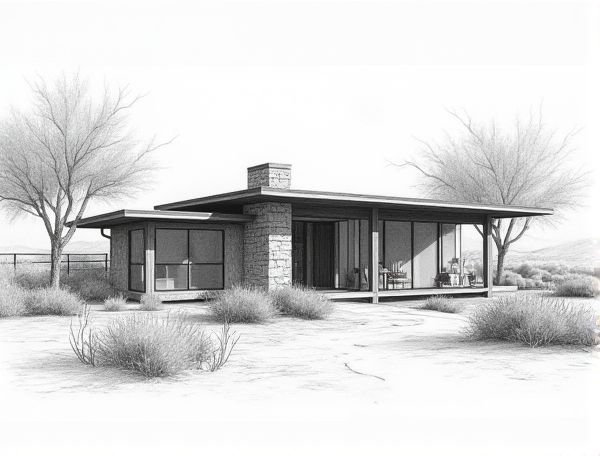
Photo illustration: Desert home design with passive solar orientation
Desert home design with passive solar orientation maximizes natural heating and cooling by strategically positioning windows and insulation to harness the sun's energy efficiently. Explore this article to discover how Your home can stay comfortable year-round while reducing energy costs.
Introduction to Desert Home Design
Desert home design emphasizes sustainable architecture that adapts to arid climates by maximizing natural cooling and minimizing heat gain. Key elements include thick insulation, shaded windows, and the use of earth tones and materials that blend with the natural desert landscape. Incorporating features like courtyards, water-efficient landscaping, and solar energy systems enhances comfort and energy efficiency in desert environments.
Principles of Passive Solar Orientation
Maximize your home's energy efficiency by aligning windows and living spaces to capture optimal sunlight throughout the day, reducing heating and cooling costs. Incorporate thermal mass materials like concrete or stone floors that absorb heat during the day and release it at night to maintain comfortable indoor temperatures. Design overhangs and shading devices to prevent excessive solar gain in summer while allowing low-angle winter sunlight to naturally warm your home.
Site Selection and Building Placement
Site selection for your home design should prioritize factors such as soil stability, sunlight exposure, and proximity to utilities to ensure a safe and efficient build. Strategic building placement optimizes natural light, enhances energy efficiency, and preserves the surrounding landscape, creating a harmonious living environment.
Maximizing Natural Daylighting
Maximizing natural daylighting in your home design enhances energy efficiency by reducing reliance on artificial lighting and improves indoor comfort by boosting mood and productivity. Strategic placement of windows, skylights, and light tubes, combined with reflective interior surfaces and open floor plans, ensures optimal light distribution throughout your living spaces.
Thermal Mass Strategies for Desert Climates
Thermal mass strategies in desert climates involve using materials like concrete, adobe, or brick to absorb heat during the day and release it at night, stabilizing indoor temperatures. High thermal mass walls combined with proper insulation and shading can reduce reliance on mechanical cooling systems and enhance energy efficiency. Incorporating night ventilation and strategic window placement further optimizes heat dissipation and comfort in arid environments.
Shading Solutions for Solar Control
Effective shading solutions for solar control reduce heat gain and glare, enhancing indoor comfort while lowering energy costs. Your home can benefit from strategically placed awnings, pergolas, and adjustable louvers that optimize natural light and protect against harsh sunlight.
Window Design and Glazing Techniques
Window design and glazing techniques significantly enhance your home's energy efficiency and aesthetic appeal by optimizing natural light and thermal insulation. Incorporating double or triple glazing with low-emissivity coatings reduces heat transfer, while strategic window placement maximizes daylight and ventilation.
Roof and Wall Insulation Approaches
Effective roof and wall insulation approaches utilize materials like spray foam, rigid foam boards, and fiberglass batts to enhance thermal resistance and reduce energy loss. Implementing continuous insulation systems and air barriers minimizes thermal bridging, improves indoor comfort, and lowers heating and cooling costs.
Landscape Integration for Microclimate
Effective landscape integration enhances your home's microclimate by strategically using plants and hardscaping to regulate temperature, humidity, and wind patterns. Incorporating native vegetation and shading elements reduces energy consumption while promoting natural cooling and improved air quality. Thoughtful placement of trees, shrubs, and water features creates a balanced outdoor environment that supports sustainable living and increases comfort year-round.
Energy-Efficient Materials and Finishes
Energy-efficient materials and finishes such as insulated concrete forms, low-emissivity windows, and reflective roofing significantly reduce your home's energy consumption by minimizing heat transfer and improving insulation. Incorporating products like recycled steel framing and VOC-free paints enhances sustainability while maintaining indoor air quality and long-term durability.
 homedesy.com
homedesy.com